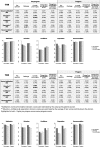A Patient-Focused Technology-Enabled Program Improves Outcomes in Primary Total Hip and Knee Replacement Surgery
- PMID: 30229224
- PMCID: PMC6133096
- DOI: 10.2106/JBJS.OA.16.00023
A Patient-Focused Technology-Enabled Program Improves Outcomes in Primary Total Hip and Knee Replacement Surgery
Abstract
Background: A patient-engagement and pathway-management program for patients undergoing primary total hip and knee replacement was evaluated. Health-service and multimedia features supported by technology were integrated with existing enhanced recovery after surgery (ERAS) practices. The primary objective was to demonstrate the impact on length of stay. The secondary objective was to assess the impact on clinical, patient-focused, and financial outcomes.
Methods: Two thousand and eighty consecutive patients undergoing primary total hip replacement (n = 1,034) and total knee replacement (n = 1,046) were classified into "pre-program" (retrospectively assessed [n = 1,038]) and "program" (prospectively assessed [n = 1,042]) cohorts. Patients in the program cohort were subdivided according to those who were eligible for criteria-based outreach support (OS) (n = 401) and those who were ineligible for this service (NOS) (n = 641). Clinical outcomes were assessed for all patients, and patient-focused outcomes were assessed for a subset (n = 223).
Results: The mean reduction in length of stay ranged from 20% (1.2 days) to 42% (2.5 days) following total hip replacement and from 9% (0.6 day) to 31% (2 days) following total knee replacement (p < 0.001). Clinical outcomes (readmissions, complications, emergency department re-attendance rates) were not significantly negatively impacted. The Oxford Hip Score had numerically larger improvement after total hip replacement in the OS group than in the pre-program group (4.1-point increase), and the Oxford Knee Score had numerically larger improvement after total knee replacement in the NOS group than in the pre-program group (0.8-point increase). The patients in the program cohort (either OS or NOS) rated overall health gain as higher than those in the pre-program cohort (gain in numerical rating scale, 1.4 points for patients managed with total hip replacement, 0.6 points for patients managed with total knee replacement). Older patients and those with higher comorbidity indices benefited most with respect to length of stay and multiple clinical outcomes. Patient experience was significantly improved across domains (p < 0.001 to p = 0.003). Potential savings for patients managed with total hip replacement (£401.64 [$267.76] per patient) exceeded estimated program charges of £50 [$33.33] to £60 [$40] per patient, whereas the potential savings for patients managed with total knee replacement (£76.67 [$51.11] per patient) were sufficient to achieve a reduction of total system costs.
Conclusions: Technology-enabled programs may deliver enhanced care at lower costs for patients undergoing lower-limb arthroplasty. Shorter durations of inpatient stay without a negative impact on clinical outcomes and improved patient-focused outcomes and experience can deliver substantial value that can be especially beneficial for older patients and those with greater medical complexity.
Level of evidence: Therapeutic Level III. See Instructions for Authors for a complete description of levels of evidence.
Figures









References
-
- Hansson T, Hansson E, Malchau H. Utility of spine surgery: a comparison of common elective orthopaedic surgical procedures. Spine. 2008. December 01;33(25):2819-30. - PubMed
-
- Jenkins PJ, Clement ND, Hamilton DF, Gaston P, Patton JT, Howie CR. Predicting the cost-effectiveness of total hip and knee replacement: a health economic analysis. Bone Joint J. 2013. January;95-B(1):115-21. - PubMed
-
- National Joint Registry for England. Wales, Northern Ireland, and the Isle of Man. 11th annual report of the National Joint Registry. http://www.njrcentre.org.uk/njrcentre/Portals/0/Documents/England/Report...
-
- Norman-Taylor FH, Palmer CR, Villar RN. Quality-of-life improvement compared after hip and knee replacement. J Bone Joint Surg Br. 1996. January;78(1):74-7. - PubMed
LinkOut - more resources
Full Text Sources
Other Literature Sources
Research Materials
